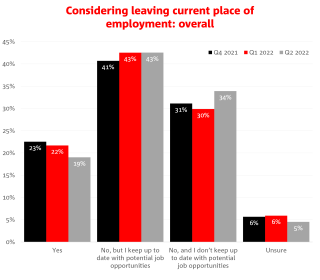New data from NAB reveals Australians remain very active in the jobs market, with around one in five (19%) looking to change jobs. While this is marginally below last quarter (22%), it remains high as Australian workers look at the opportunities in a tight labour market.
A further two in five workers (43%) are keeping up to date with new opportunities despite not currently considering leaving their current job.
Clear patterns continue to be evident by age group. Younger workers were again most likely to be considering a change of jobs in Q2 (unchanged at 24%, or around one in four), with this number stepping down progressively in each age group to just 8% in the over 65 group (down from 13% in Q1).
The NAB Economics research – ‘The Changing Workforce’ – also highlights work from home activity and preferences, with Australians typically wanting to work half their time at home. However, for now, the average Australian works two-thirds of the time outside their home.
NAB Executive for Business Metro, Michael Saadie, said the current decades-low rate of unemployment was great news and workers were aware of the opportunities it created.
“Australians were understandably wary to move jobs in the early days of the pandemic given the uncertain environment,” Mr Saadie said.
“However, the economy rebounded sharply last year and into 2022, creating a job hunter’s market with unemployment now around its lowest level in decades.
“As a result, it has given confidence to many Australians – particularly young Australians – to look at changing jobs and even careers over the past 12 months.
“While money is a factor, our research suggests it’s typically not the primary cause for leaving a job. The top two reasons for leaving are a lack of personal fulfilment and lack of career growth – but there are many who just feel like a fresh start.”
Intentions to leave job by industry were highest in the Mining & Agribusiness sectors at around 34%.
By job type, digital & data workers were the most active, seeking to capitalise on the ever-growing demand for tech skills. Just over a quarter of workers in the digital area were looking to change jobs, while sales workers and labourers were similarly active.
Mr Saadie said the pandemic had fundamentally changed the labour market and employers now had to look at different ways to attract and retain talent; be that new types of leave, wellbeing initiatives or learning and development.
“We continue to hear from small and medium businesses about the difficulty in hiring the right talent to keep their business growing as quickly as they want,” Mr Saadie said.
“While the strength of the jobs market is great to see, it does create challenges with a broad labour shortage that is impacting most sectors of the economy.
“After decades of low employee turnover, we’re seeing businesses work harder than ever to retain and attract talent.
“At NAB we’re focused on supporting colleagues build their skills, with over 7000 colleagues receiving training in cloud skills through our Cloud Guild and more than 6000 graduating through our Career Qualified in Banking program.”
Circle In is one company taking a fresh approach to attracting and retaining talent. Co-founder Jodi Geddes said her business was adapting to the changing environment with new benefits for staff members.
“Covid fundamentally changed the workplace – expectations around flexible work arrangements are far different to what they were pre-pandemic,” Ms Geddes said.
“We ran research with our employees, and they told us the most valuable thing we could give them was time, not money.
“So, this year we’ve introduced a new type of personal leave – life leave – which is another five days on top of annual leave that can be used on life. Our people are already telling us that this is by far the most valued benefit.”
Office intentions
Australians are currently spending 34% of their work week at home, on average. This is down from 38% last quarter.
However, in an ideal world, Australian workers say they would like, on average, 48% of their work week at home, with commute time listed as the main barrier to heading into the office.






